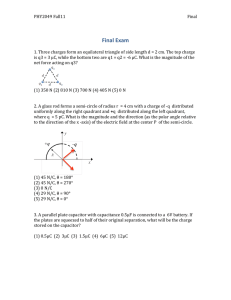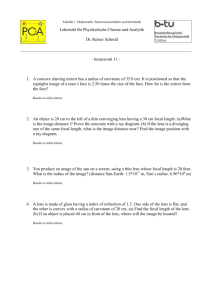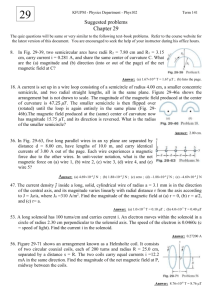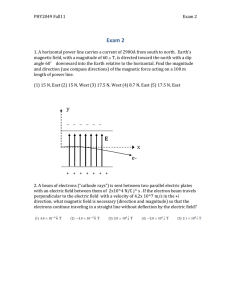Document 10388195
advertisement
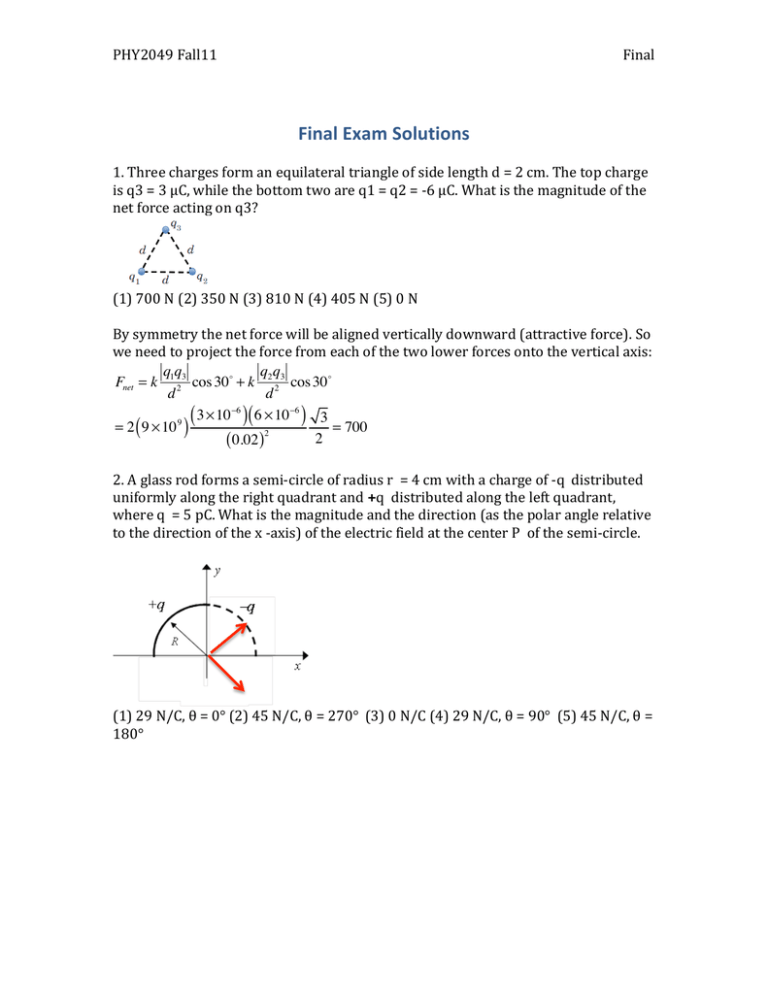
PHY2049 Fall11 Final Final Exam Solutions 1. Three charges form an equilateral triangle of side length d = 2 cm. The top charge is q3 = 3 μC, while the bottom two are q1 = q2 = -­‐6 μC. What is the magnitude of the net force acting on q3? (1) 700 N (2) 350 N (3) 810 N (4) 405 N (5) 0 N By symmetry the net force will be aligned vertically downward (attractive force). So we need to project the force from each of the two lower forces onto the vertical axis: qq qq Fnet = k 1 2 3 cos 30 + k 2 2 3 cos 30 d d −6 3 × 10 ) ( 6 × 10 −6 ) 3 9 ( = 2 ( 9 × 10 ) = 700 2 ( 0.02 )2 2. A glass rod forms a semi-­‐circle of radius r = 4 cm with a charge of -­‐q distributed uniformly along the right quadrant and +q distributed along the left quadrant, where q = 5 pC. What is the magnitude and the direction (as the polar angle relative to the direction of the x -­‐axis) of the electric field at the center P of the semi-­‐circle. (1) 29 N/C, θ = 0° (2) 45 N/C, θ = 270° (3) 0 N/C (4) 29 N/C, θ = 90° (5) 45 N/C, θ = 180° PHY2049 Fall11 Final The diagram shows the direction of the electric field contribution from each quadrant. By symmetry, the net field points down in the î direction, which is θ = 0 The magnitude (not really needed to choose the correct answer!) is given by: q λ= π R 2 dq = λ ds = λ Rdθ π π dq λ Rdθ Ey+ q = ∫ k 2 sin θ = ∫ k sin θ π /2 R π /2 R2 λ λ = −k cosθ |ππ /2 = k R R λ 4k q ⇒ Eytot = 2k = = 29 R π R2 3. A parallel plate capacitor with capacitance 0.5μF is connected to a 6V battery. If the plates are squeezed to half of their original separation, what will be the charge stored on the capacitor? (1) 6μC (2) 3μC (3) 1.5μC (4) 0.5μC (5) 12μC A The capacitance of a parallel plate capacitor is C = ε 0 , so the capacitance d increases two times when the plates are squeezed together. So the new capacitance is 1 μF. The charge is thus q = CV = 6 µC PHY2049 Fall11 Final y + + + + + + + E e-­‐ x − − − − − − 4. A beam of electrons (“cathode rays”) is sent between two parallel electric plates with an electric field between them of E = -­‐ 2x10^4 N/C j-­‐hat N/C . If the electron beam travels perpendicular to the electric field with a velocity of v = 4.2x 10^7 m/s in the +i -­‐hat direction, what magnetic field is necessary (direction and magnitude) so that the electrons continue traveling in a straight line without deflection by the electric field? Balance forces: Replace k with –k below: F = q(E + v × B) = 0 ⇒E+ v×B = 0 E ⇒ B = k̂ so that ĵ × k̂ = − î v E = 2 × 104 N/C v = 4.2 × 107 m/s ⇒B= 2 × 104 N/C = 0.48 mT 4.2 × 107 PHY2049 Fall11 Final 5. Part of a long insulated wire carrying current i = 4A is bent into a circular section of radius R = 1.5 cm as shown in the figure. What is the magnitude of the magnetic field (in T) at the center of curvature C if the circular section lies in the plane of the page as shown? (1) 2.2 x 10-­‐4 (2) 5.3 x 10-­‐5 (3) 1.7 x 10-­‐4 (4) 1.1 x 10-­‐4 (5) 5.0 x 10-­‐6 The field from the long straight wire is given by µi Bw = 0 out of the page at the center of the circle. 2π R The field from the circular loop itself is given by the Biot-­‐Savart law: µi µi Bloop = 0 φ = 0 also out of the page 4π R 2R Both contributions add, given a field B=2.2 x 10-­‐4 6. A series RLC circuit is driven by a sinusoidally-­‐varying EMF source. The current lags the EMF by 30°. What can be concluded about the driving frequency ω? 1 1 1 (1) ω > (2) ω < (3) ω = (4) ω = 0 (5) ω = ∞ LC LC LC ε ( t ) = ε m sin (ω t ) i ( t ) = im sin (ω t − φ ) So the current lags the EMF when Φ>0 X − XC tan φ = L > 0 R X L > XC 1 ωL > ωC 1 ω2 > LC 1 ⇒ω > LC PHY2049 Fall11 Final 7. A constant current of i = 3A is used to charge a parallel plate capacitor with circular plates of radius R = 1cm. What is the magnitude of the magnetic field at a radius of r = 0.3 cm, which is less than R, in the region between the plates? (1) 1.8 x 10-­‐5 T (2) 6 x 10-­‐5 T (3) 1.2 x 10-­‐4 T (4) 3.8 x 10-­‐6 T (5) 0 T The total displacement current between the plates is id=i=3A. The effective i displacement current density is jd = d 2 πR So using Maxwell’s Law of Induction: ∫ B ⋅ ds = µ0id′ 2π rB = µ0 jdπ r 2 = µ0 B= id π r 2 π R2 µ0 id r = 1.8 × 10 −5 T 2π R 2 8. Light traveling horizontally enters a right prism as shown in the figure. The index of refraction of the prism is n=1.6, and it is surrounded by air. What is the measure of the angle θ2 that the light deflected from horizontal when it exits the prism? 45° θ1 θ2 (1) 31° (2) 26° (3) 19° (4) 45° (5) 0° There are 2 refractions from the 2 surfaces. And since the second surface is not parallel to the first, the light does not return to the incident direction. PHY2049 Fall11 Final sin 45 = 1.6sin θ1 1.6sin ( 45 − θ1 ) = sin θ 2 ⇒ θ 2 = 31o 9. An object is placed 40cm in front of a converging lens with a focal length of 60cm. Where is the image? (1) 120 cm in front of the lens (2) 60 cm behind the lens (3) 120 cm behind the lens (4) 17 cm behind the lens (5) 40 cm in front of the lens A converging lens has a positive focal length. So we use the following equation: 1 1 1 = + f p i 1 1 1 − = f p i 1 1 1 − =− 60 40 120 So the image distance is -­‐120 cm. Negative implies the same side of the lens as the object. 10. A thin anti-­‐reflective coating with an index of refraction of n1 = 1.4 is placed on a lens with an index of refraction of n2=1.5. What is the minimum coating thickness in nm needed to ensure that light of wavelength 490nm in air and of perpendicular incidence will be reflected from the two surfaces of the coating with fully destructive interference? Assume that the lens+coating is in air. (1) 88 (2) 122 (3) 490 (4) 175 (5) 245 There will be 2 reflections, one from the surface of the coating and one from the coating-­‐lens surface. We want destructive interference from the two, so they should be a half-­‐wavelength out of phase. Also, since in both reflections light travels into a medium with a higher index of refraction, there is a half-­‐wavelength shift in phase at each boundary (so it cancels out). Thus, we want twice the thickness to be an even multiple of wavelengths plus an extra half-­‐wavelength (in the coating material) PHY2049 Fall11 Final 1⎞ ⎛ ⇒ 2t = ⎜ m + ⎟ λn m=0 for minimum thickness 2⎠ ⎝ λn λ0 490nm ⇒t = = = = 87.5 nm 4 4n 4 (1.4 ) 11. A point particle with charge q is at the center of a Gaussian surface in the form of a cube. The electric flux through any one face of the cube is: (1) q/6ε0 (2) q/4πε0 (3) q/4ε0 (4) q/ε0 (5) q/16ε0 A cube has six faces. The electric flux through one face is one sixth of total flux through the surface of the cube. A: q/6ε0 12. A total charge of 7 × 10–8 C is uniformly distributed throughout a non-conducting sphere with a radius of 5 cm. The electric potential at the surface, relative to the potential far away, is about: (1) 1.3x104 V (2) -1.3x104 V (3) 7x105 V (4) -6.3x104 V (5) 0 Outside the sphere, the electric potential is identical to that of a point charge. 𝑘𝑞 𝑉= = 1.3×10! 𝑉 𝑟 A: 1.3 × 104 V 13. Five cylindrical wires are made of the same material. Their lengths and radii are wire 1: length l , radius r wire 2: length 3l / 2, radius r/2 wire 3: length l / 2, radius r/2 wire 4: length l , radius r/2 wire 5: length 5l , radius r/2 Rank the wires according to their resistances, least to greatest. (1) 1, 3, 4, 2, 5 (2) 5, 4, 3, 2, 1 (3) 1 and 2 tie, then 5, 3, 4 (4) 1, 3, 5, 2, 4 (5) 1, 2, 4, 3, 5 The resistances of the five wires are ! ! !! !! !! !"! 𝑅 = 𝜌 ! = 𝜌 !! ! , 𝜌 !! ! , 𝜌 !! ! , 𝜌 !! ! , 𝑎𝑛𝑑 𝜌 !! ! respectively. A: 1, 3, 4, 2, 5 PHY2049 Fall11 Final 14. The current in the 5.0-Ω resistor in the circuit shown is: (1) 1.5 A (2) 0.67 A (3) 0.42 A (4) 2.4 A (5) 3.0 A Apply loop rule to the loop consisting of battery, 3.0-Ω and 5.0-Ω resistors. We have 12 − 3𝑖 − 5𝑖 = 0 Solve it to get i=1.5 A. A: 1.5 A 15. A rod with resistance R lies across frictionless conducting rails in a constant uniform magnetic field B, as shown. Assume the rails have negligible resistance. The magnitude of the force that must be applied by a person to pull the rod to the right at constant speed v is: (1) B2L2v/R (2) BLv (3) BLv/R (4) 0 (5) B2Lxv/R !" !" ℇ Induced emf in the loop is ℇ = 𝐵 !" = 𝐵𝐿 !" = 𝐵𝐿𝑣. Induced current is 𝑖 = ! = !"# ! ! !! ! 𝑐𝑐𝑤. Magnetic force on the rod is 𝐹! = 𝑖𝐿𝐵 = ! to the left. Pulling force has the ! same magnitude as the magnetic force and points to the right because the rod moves with constant velocity. A: B2L2v/R PHY2049 Fall11 Final 16. A 0.70-m radius cylindrical region contains a uniform electric field that is parallel to the axis and is increasing at the rate 5.0 × 1012 V/m ⋅ s. The magnetic field at a point 0.25 m from the axis has a magnitude of: (1) 1.9x10-13 T (2) 1.4x10-13 T (3) 2.5x 10-13 T (4) 6.6x10-11 T (5) 0 T Use Maxwell’s law of induction for a circle of radius r. We have 𝑑𝐸 1 𝑑𝐸 2𝜋𝑟𝐵 = 𝜀! 𝜇! 𝜋𝑟 ! , 𝐵 = 𝜀! 𝜇! 𝑟 = 7.0×10!! 𝑇. 𝑑𝑡 2 𝑑𝑡 A: 7.0 × 10–6 T 17. A sinusoidal electromagnetic wave with an electric field amplitude of 100 V/m is incident normally on a surface with an area of 1 cm2 and is completely absorbed. The energy absorbed in 10 s is: (1) 13 mJ (2) 1.3 mJ (3) 27 mJ (4) 130 mJ (5) 270 mJ !! ! The intensity of the EM wave is 𝐼 = !!! = 13.3 𝑊/𝑚! . Energy absorbed in 10 s is U=IAt=13 mJ. ! A: 13 mJ 18. The figure shows a concave mirror with a small object located at the point marked 6. If the image is also at this point, then the center of curvature of the mirror is at the point marked: (1) 6 (2) 4 (3) 3 (4) 9 (5) 12 ! ! ! Object distance p=6, image distance i=6. Image equation ! + ! = ! gives r=6. A: 6 PHY2049 Fall11 Final 19. The diagram shows a single slit with the direction to a point P on a distant screen shown. At P, the pattern has its second minimum (from its central maximum). If X and Y are the edges of the slit, what is the path length difference (PX) – (PY)? (1) 2λ (2) λ (3) 3 λ /2 (4) λ /2 (5) 5 λ/ 2 Second minimum of single slit occurs when 2𝑎𝑠𝑖𝑛𝜃 = 2𝜆. (PX) – (PY)=2𝑎𝑠𝑖𝑛𝜃 = 2𝜆. A: 2λ 20. Monochromatic light is normally incident on a diffraction grating that is 1 cm wide and has 10,000 slits. The first order line is deviated at a 30° angle. What is the wavelength, in nm, of the incident light? (1) 500 (2) 400 (3) 300 (4) 600 (5) 1000 The grating spacing is 𝑑 = Solve it to get wavelength. A: 500 !×!"!! !"! = 10!! 𝑚. We have 𝑑𝑠𝑖𝑛𝜃 = 𝜆 for 1st order maximum.
